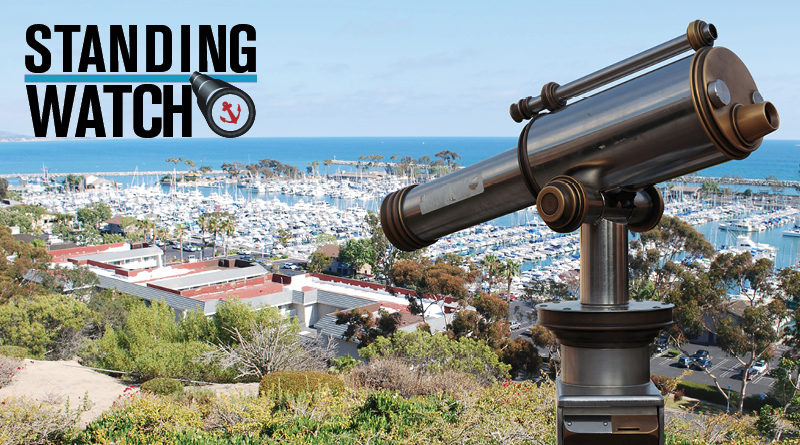Wall of Death: Will Feds challenge use of international driftnets?
Senators and representatives have been proposing bills on controversial fishing practice in recent years, but is the United States standing tough on the global stage?
NATIONWIDE—Labeling anything as a “Wall of Death” is certain to capture the attention of, well, anyone who is paying attention to whatever is being labeled as a Wall of Death. In this instance the Wall of Death is a drift gillnet, also known as a driftnet. Most people reading The Log are familiar with driftnets. For those who don’t know: Driftnets are long nets, sometimes miles in length, placed along the ocean floor for the purpose of catching fish.
Driftnets, which can also be referred to as gillnets, have come under attack in recent years, however, because of their collateral damages: innocent fish species not targeted by the miles-long net are often captured as bycatch. Federal agencies such as the National Oceanic and Administrative Administration, or NOAA, have been reviewing proposals to keep certain seafood imports out of the United States because they were caught with driftnets – and placed other species in danger of being endangered or extinct (such as the vaquita in Mexico or Māui dolphin in New Zealand).
Environmental groups, meanwhile, have taken the Trump Administration to court and accused the President and the departments he oversees of failing to properly enforce the Marine Mammal Protection Act in the Sea of Cortez. Vaquitas there have virtually disappeared, mostly because hundreds of them died after being caught into driftnets. (The driftnets were set along the Sea of Cortez floor to catch totoaba, which sells for quite the high price on the black market.)
The United States is making progress in eliminating driftnets from circulation within our waters. Should the United States, however, be more proactive in playing international police and proactively challenging commercial fishers in other countries from engaging in a fishing practice all but banned domestically? What obligation does the Trump Administration have in enforcing the Marine Mammal Protection Act (courts seem to think the administration does have an obligation to do so)? Should the United States regularly resort to banning the import of seafood from commercial fisheries that use driftnets in their fishing practices?
Current proposals
Rep. Alan Lowenthal, D-Long Beach, introduced H.R. 1305 – the Albatross and Petrel Conservation Act – earlier this year. Rep. Ted Lieu, D-Torrance, is one of the bill’s co-sponsors. H.R. 1305 proposes to update the High Seas Driftnet Fishing Moratorium Protection Act. The updated act’s updated language would protect non-target fish and marine mammals, as directed by accords such as the Marine Mammal Protection Act of 1972 and the Endangered Species Act of 1973.
H.R. 788, introduced by Rep. Daniel Webster, R-Florida, also proposes a few clarifications to the High Seas Driftnet Fishing Moratorium Protection Act – though the changes here specifically focus on protection of sharks. Lieu is also a co-sponsor of this bill. This bill was reportedly introduced to increase regulation of the international shark trade.
Back up in Washington – state, not district – state senators are deliberating a proposal to phase out non-tribal salmon gillnet licenses by the end of 2022.
“Many other states have banned gill nets, and we should end nonselective netting,” a legislative analysis of the Washington state proposal – Senate Bill 5617 – stated.
The same legislative analysis also pondered whether other factors also contribute to the decline of various fish or marine mammal species.
“[Fishers using] gillnets are selective by fishing during limited times and place,” the legislative analysis of Washington’s SB 5617 continued. “Gillnet fishers fish sustainably. Habitat degradation and a decrease in hatchery production are the real problem, not gillnet fishing.”
Recent History
The use of driftnets in the United States, when all is said and done, appears to be a dying practice.
States such as Oregon and Washington have been proactively regulating commercial fisheries using driftnets of their respective coasts. Drillnet activities are not allowed off the Atlantic Ocean or Gulf of Mexico coasts.
California finally boarded the driftnet regulation train when State Sen. Ben Allen’s proposal to ban the fishing tool was signed into law by then Gov. Jerry Brown in 2018.
Sen. Dianne Feinstein, D-California, separately introduced a bill during the previous legislative session to phase out large driftnets off the coast of California.
“The driftnets, which can be more than a mile long, are left in the ocean overnight to catch swordfish and thresher sharks. However, at least 60 other marine species, including whales, dolphins, sea lions, sea turtles, fish and sharks, can also become entangled in the large mesh nets, injuring or killing them. Most of these animals, referred to as bycatch, are discarded,” Feinstein’s office stated in a released statement about the Driftnet Modernization and Bycatch Reduction Act.
Feinstein’s bill, which was co-sponsored by Sen. Kamala Harris, D-California, was introduced prior to the enactment of California’s own legislation phasing out driftnets. There are still legislative efforts, however, updating federal protections of various fish, marine mammals and sea turtles from driftnets. At least two bills are currently circulating in the House of Representatives, with elected officials from California either authoring or co-sponsoring those proposals.


